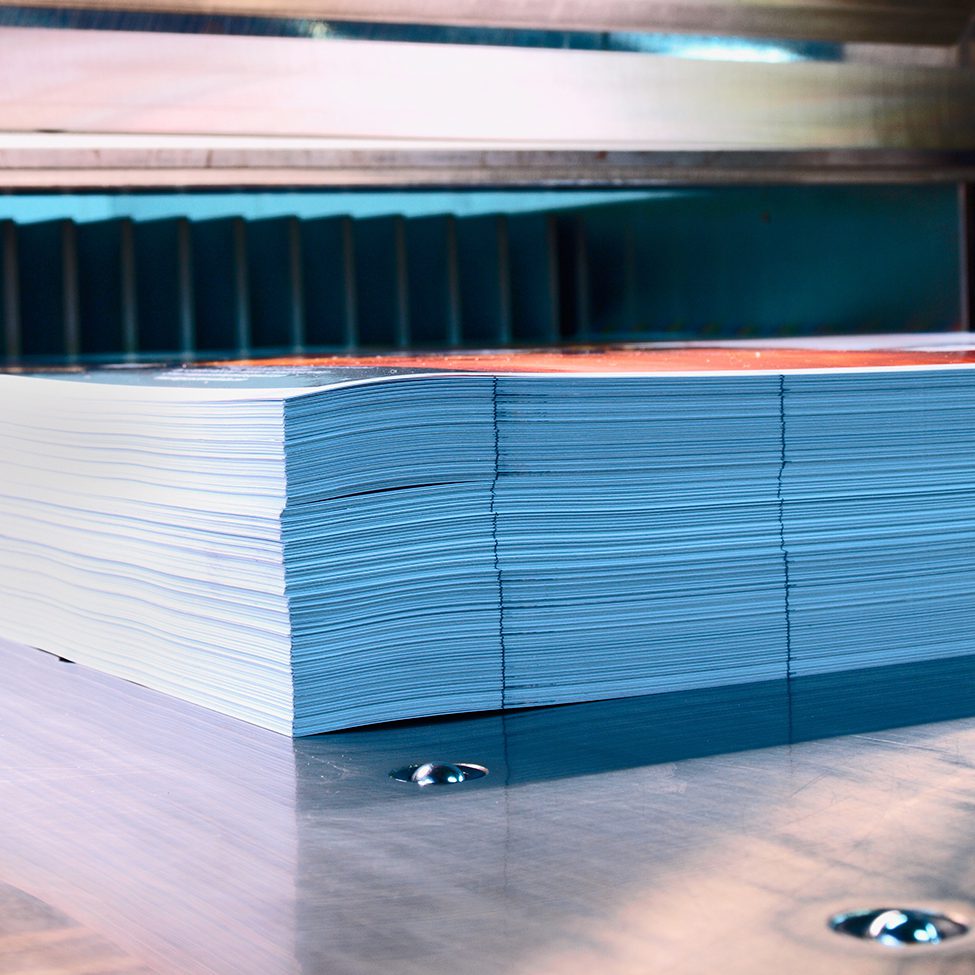Welcome to the penultimate post in our Life Cycle of a Print Job series! Today we’re detailing all of the finishing options available after the ink has dried. Well, maybe not ALL of the options, but a lot of them!
If you missed the first four parts of the series, you can read the overview HERE; check out the post about quoting and placing an order HERE; learn the ins and outs of Prepress HERE; and get the details on all things Printing HERE.
Once printed sheets are off press and the schedules are put together for each step of the finishing process, it’s time for the bindery to get to work!
The majority of the projects we print are finished in-house. The small amount that require equipment we don’t have, go to outside binderies for specialty finishing.
Cutting
Cutting is the operation of separating printed pieces on a press form. This is done using a single-knife guillotine cutter. About 95% of the jobs we do hit the cutter before any other process. Depending on the job, it may be the only finishing operation required, and/or it may have to come back to the cutter for final trimming.
Folding
Folding is the process of bending and creasing paper to form a finished piece or a multipage signature. Folding is usually done mechanically by machines that are increasingly computer-controlled. For intricate pieces, hand folding may be the only option. Large format automated folding equipment uses a series of rollers and plates to fold the paper down to the finished size or for the next step in finishing (like saddle stitching).
Inline Gluing
Inline gluing uses a special folder attachment that applies dots of fugitive glue to seal folded pieces of paper, usually self mailers. There are limitations to where the glue can be applied, so it’s best to confirm what is feasible with your printer. If spot gluing cannot be done by machine, glue adhesive dots or fugitive glue can be applied by hand.
Saddle Stitching
Saddle stitching is the process of binding multiple sheets of paper by opening the signatures in the center, gathering and stitching them with a wire through the fold line. The folded sheets rest on supports called saddles as they are transported through the stitcher. Booklets, brochures, and pamphlets are most often bound this way.
Wire-o/Coil Binding
Wire-o and coil binding are both forms of mechanical binding using double loop wire, plastic strips, combs, or coils in place of stitching. The binding edge is punched with slots or holes through which the formed plastic material is inserted.
Die Cutting
Die cutting uses sharp steel rules to slice paper or board to a specific shape on a platen press or specialized stamping press. Diecuts are common in pocket folders, stickers, tabs, greeting cards, and pop-up books. Diecuts are also made to form the shape of flat packaging pieces (envelopes, boxes, etc.) before they are constructed.
Specialty Finishes
UV Coating
UV coating is a liquid glossy coating applied to the surface of the paper and cured with ultraviolet light. UV coating is also available in a matte finish.
Lamination
Lamination is a plastic film bonded by heat and pressure to a printed sheet to provide protection or enhance appearance.
Foil Stamping
Foil stamping uses foil and a heated metal die to press a design or image on paper without the use of ink. Foil can be metallic, glossy or flat.
Embossing/Debossing
Embossing is the process of sandwiching paper between a relief pattern die and a recessed counter die under heat and pressure. The result is a permanent raised pattern in the paper. Debossing is the reverse process, where the image is pressed from below the surface of the paper and results in a depressed image, rather than raised.
Perfect/Case Binding
Perfect binding is a binding technique in which pages/signatures are collated into a book block, and then glued together and attached to the cover with an adhesive.
Case binding is the technique used to produce a hardcover book. Printed sheets or foil stamped fabric is glued to rigid board material forming a hardcover “case,” and the case is then affixed to the text signatures with glued endsheets.
If there are other finishing techniques we did not cover here but that you’re interested in learning about, please reach out to us at any time.


One thought on “Life Cycle Of A Print Job: Finishing”
Comments are closed.